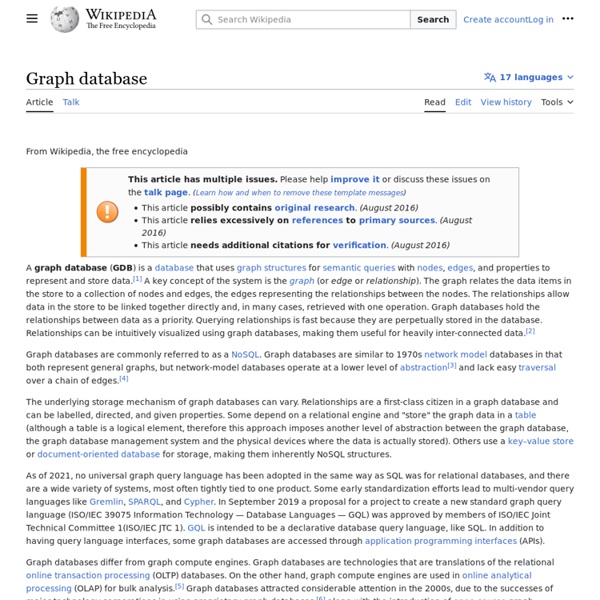phpCallGraph - A Static Call Graph Generator for PHP
Titan
Titan is a scalable graph database optimized for storing and querying graphs containing hundreds of billions of vertices and edges distributed across a multi-machine cluster. Titan is a transactional database that can support thousands of concurrent users executing complex graph traversals in real time. In addition, Titan provides the following features: Download Titan or clone from GitHub. Read the Titan documentation and join the mailing list. <dependency><groupId>com.thinkaurelius.titan</groupId><artifactId>titan-core</artifactId><version>1.0.0</version></dependency><! // who is hercules' grandfather? Continue with the Getting Started with Titan guide for a step-by-step introduction.
XML database
An XML database is a data persistence software system that allows data to be stored in XML format. These data can then be queried, exported and serialized into the desired format. XML databases are usually associated with document-oriented databases. Two major classes of XML database exist:[1] XML-enabled: these may either map XML to traditional database structures (such as a relational database[2]), accepting XML as input and rendering XML as output, or more recently support native XML types within the traditional database. Rationale for XML in databases[edit] O'Connell gives one reason for the use of XML in databases: the increasingly common use of XML for data transport, which has meant that "data is extracted from databases and put into XML documents and vice-versa".[3] It may prove more efficient (in terms of conversion costs) and easier to store the data in XML format. XML Enabled databases[edit] RDBMS that support the ISO XML Type are: Example of XML Type Query in IBM DB2 SQL[edit]
bendiken/rdf - GitHub
Analytics in Action: Breakthroughs and Barriers to ROI
As these comments suggest, when analytics does not work as expected for a company, it is helpful to look for the source of the problem in the three most common reasons why: Measuring the Wrong Metrics: Companies are measuring the wrong things or have gaps in the way they are measuring (e.g. around the customer experience).Flawed Insights: Users are not identifying and validating cross-functionally the correct insights and associated actions suggested.Faulty Execution: Companies fail to embed analytical insights in key decision processes across the enterprise so that analytics capabilities are linked to business outcomes. Using this approach to understand root causes preventing the achievement of expected business outcomes enables organizations to course correct in a closed learning loop process. The smartest businesses are creating a virtuous feedback loop that lets them collect data, analyze the data, harvest insights and then make decisions and respond in an increasingly agile style.
HyperGraphDB - A Graph Database
HyperGraphDB is a general purpose, extensible, portable, distributed, embeddable, open-source data storage mechanism. It is a graph database designed specifically for artificial intelligence and semantic web projects, it can also be used as an embedded object-oriented database for projects of all sizes. The system is reliable and in production use is several projects, including a search engine and our own Seco scripting IDE where most of the runtime environment is automatically saved as a hypergraph. HyperGraphDB is primarily what its carefully chosen name implies: a database for storing hypergraphs. While it falls into the general family of graph databases, it is hard to categorize HyperGraphDB as yet another database because much of its design evolves around providing the means to manage structure-rich information with arbitrary layers of complexity. For instance, a relational as well as an object-oriented style of data management can be emulated. Key Facts Possible Usage Scenarios
The Benefits of Titan · thinkaurelius/titan Wiki
Titan is designed to support the processing of graphs so large that they require storage and computational capacities beyond what a single machine can provide. This is Titan’s foundational benefit. This section will discuss the various specific benefits of Titan and its underlying, supported persistence solutions. General Titan Benefits Support for very large graphs. Benefits of Titan with Cassandra Continuously available with no single point of failure. Benefits of Titan with HBase Tight integration with the Hadoop ecosystem. Titan and the CAP Theorem When using a database, the CAP theorem should be thoroughly considered (C=Consistency, A=Availability, P=Partitionability). “Despite your best efforts, your system will experience enough faults that it will have to make a choice between reducing yield (i.e., stop answering requests) and reducing harvest (i.e., giving answers based on incomplete data). Titan In-Memory
Document-oriented database
This article is about the software type. For usage/deployment instances, see Full text database. A document-oriented database is a computer program designed for storing, retrieving, and managing document-oriented information, also known as semi-structured data. Document-oriented databases are inherently a subclass of the key-value store, another NoSQL database concept. XML databases are a specific subclass of document-oriented databases. Documents[edit] The central concept of a document-oriented database are the documents, which is used in usual English sense of a group of data that encodes some sort of user-readable information. To understand the difference, consider this text document: Bob Smith 123 Back St. Although it is clear to the reader that this document contains the address for a contact, there is no information within the document that indicates that, nor information on what the individual fields represent. Now consider the same document marked up in pseudo-XML: See also[edit]



